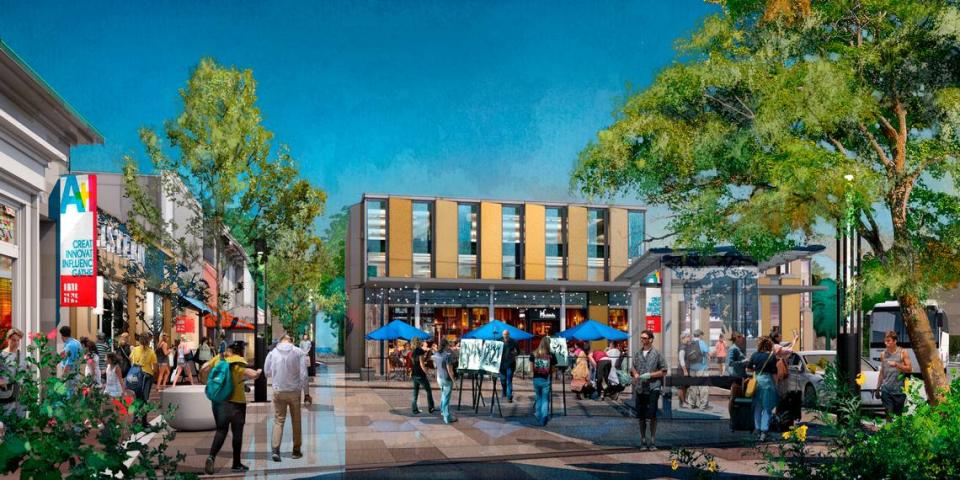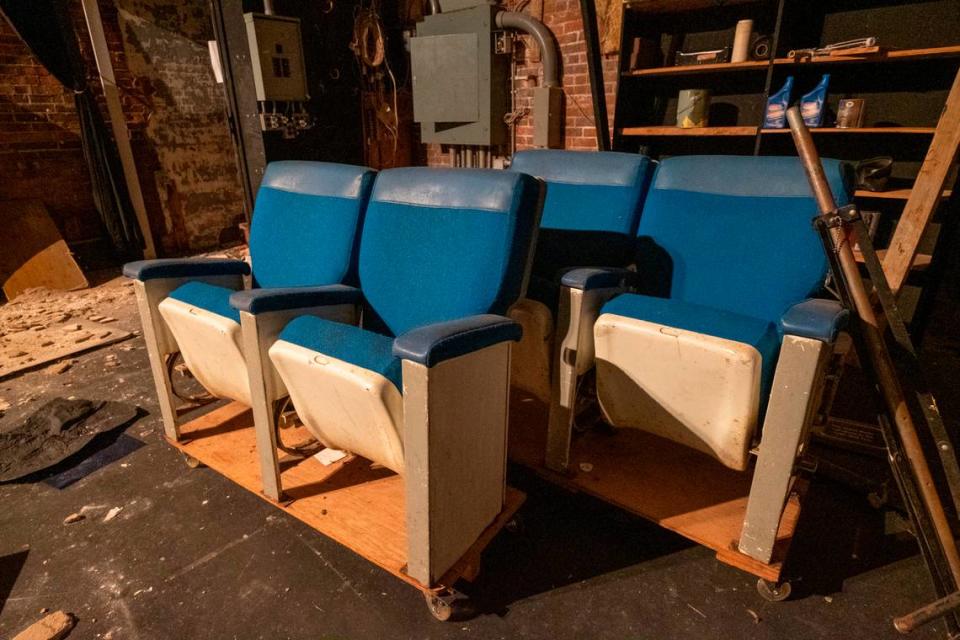Downtown Myrtle Beach wants to be a magnet for arts and culture. CCU is buying in.
Shortly before being crowned Miss South Carolina 1955, Martha Dean Chestnut made a stop along Main Street in Myrtle Beach.
Chestnut met with Helen Mates, a fashion maven whose dress shop was an epicenter of activity that anchored a thriving merchant sector throughout the 50s and 60s.
It closed in 1970 after a 23-year run, just as the era of big box stores and super-sized malls was beginning to draw consumer attention away from the locally owned businesses that powered America’s urban economies for more than a century.
City leaders are preparing to heavily invest into an audacious plan they hope brings a cultural renaissance to the heart of South Carolina’s tourism mecca: A $12 million renovation of the Mates store and two other connected buildings into the 300-seat Broadway Theatre in the heart of downtown to key a cultural renaissance here not seen in a generation.
“We want to be the new destination for the arts in South Carolina .. We just want to let the world know what we do, because we’re doing amazing work here,” said Claudia Bornholdt, dean of Coastal Carolina University’s Edwards College of Humanities and Fine Arts.
As Myrtle Beach embarks on a landscape-altering strategy to develop an arts and innovation district in its original downtown core, The Sun News dove deep into city planning documents, conducted dozens of interviews, culled archival materials and toured several sites as part of a comprehensive look into the long-term plan: One that Mayor Brenda Bethune has said could spur as much as $1 billion worth in private capital.

A college atmosphere downtown
A fully operational downtown playhouse could be used up to 360 days a year and bring in revenues surpassing $1.3 million within a decade, according to a March market analysis by New York-based consultant Webb Management.
Brian Tucker, the city’s assistant manager with an extensive background in economic development, said CCU’s involvement is critical for success and was brought on from the earliest stages as partner.
“We need that college atmosphere, that institutional atmosphere, downtown,” Tucker said.
Webb Management interviewed more than 20 leading arts and community leaders and found organizations including the Coastal Dance Center, Long Bay Theatre, Long Bay Youth Symphony and Myrtle Beach Area Children’s Theatre as potential users.
Bethune said the city wanted a big ticket project to start early in the district’s development, and the theater was an obvious choice.
“It’s bringing life back to several buildings that are historic to our community in a way that will bring life and vibrancy to Main Street,” she said. “The theatre will most likely be one of the first renovations on Main Street, which we hope will entice other property owners to follow our lead.”
Dean Bornholdt said CCU was quick to get behind the idea, seeing the theater not only as a way to bring its cultural programming off campus, but as a state-of-the art facility that can be used for academic purposes, such as lighting and stage design, business management and art direction.
“It’s a great marketing tool. And honestly, it’s a great recruiting tool,” she said. “If you have people on vacation and they see the work (at the theater), they think, ‘wow, I can study at Coastal Carolina University, and it’s high-quality work.”
Webb Management said CCU’s strong brand positions the theater for success almost immediately.
“The partnership brings significant activity and a skilled operator to downtown Myrtle Beach, where the CCU students, faculty, staff and supporters will do much to drive the redevelopment of the area,” its report states.
Thousands are expected to attend events
In addition to the nearly 3,000-square-foot stage, the facility will have a 35-seat multipurpose room, an outdoor patio and large lobby area with room for 250 people.
“For us, it’s another catalytic project. Grand Strand Brewery, Nance Plaza, the rehab of the Ninth Avenue buildings, all of those are components in creating that forward momentum,” Tucker said. “This is the biggest visible one, for sure, but I think all of these things have been leading up and ramping up to a whole different vibe for that arts and innovation district.”
The city has tried once before to partner with CCU in the hopes of bringing a performing arts center into the downtown.
In 2013, voters approved a ballot question allowing for a property tax increase to pay for the construction of a $10 million venue — a 35,000-square-foot site next to the city’s Convention Center to seat 720.
That plan fell apart partly because CCU wanted a smaller site and council members sought ways to lessen the tax burden on property owners.
Tucker said the city is finalizing planning documents with CCU for the Broadway venture before launching a public relations campaign. Tax credits are expected to help offset some of the costs, and construction could start some time next year.
Webb Management found some skepticism among those interviewed for its report.
“Some in the community see this project as a poor consolation after the drive to develop a new, larger performing arts center,” it noted.
Bornholdt believes the proposed location along with its scaled back size is a winning formula for downtown.
“We’re very ambitious here in our college because we have arts programs here that are among the very best in the state and I’m not just saying that because I’m the dean,” she said. “So for us to show that in a brand new facility in the middle of Myrtle Beach -- one of the biggest tourist destinations -- is phenomenal.”
By the third year of operation, the theater could draw an audience of more than 31,000, Webb consultants said.
The theater is a return to glory for a run-down piece of history
To the untrained eye, it’s impossible to know the dilapidated block of Main Street buildings once home to Mates’ shop, the J&J Drugstore and Ben’s Broadway Theater were ever a hub of activity.
The windows have been darkened so passersby can’t see the mess inside. Crushed glass litters the floor. Mold has climbed up the walls and given the area a dank, musty smell.
Fliers are tossed around touting community events and local productions from the mid-1990s.
In one area of the old theater are several torn up cinema seats, their blue cloth pulled away to reveal the foam padding.
Sitting on the table in a second floor production room at 811 Main St. is a yellowed edition of The Sun News dated Sept. 30, 1989. The front page is dominated by an aerial shot of Surfside Beach a week after it was flattened by Hurricane Hugo.
On the other side of the room, a stack of magazines. The November 1991 edition of “InMotion” sits atop them.
There are also specs from the failed performing arts venture, curled at the edges with the city logo visible.
Haley Morgan is rooting for the project’s success.
“I believe that theater is forming our next generation. I would love this area to have a beautiful theater that could be rented out. I believe what theater does for our youth, I don’t think sports is doing,” Morgan, a retired Radio City Rockette and founder of Myrtle Beach Area Children’s Theatre, said.
Her company took home “Excellence in Acting” awards from the Junior Theater Festival this year and in 2019, but it doesn’t have a home stage.
“It is difficult to find something. You have to reach out to the schools and they’re very typically high priced,” she said. “So if any of the theaters are like, ‘we want to support children’s theater,’ we’re listening.”
For Bornholdt, the value of Myrtle Beach’s downtown theater isn’t from ticket sales or merchandising revenue.
“If you look at a lot of cities or neighborhoods in larger cities, it’s usually the artists that move in first and bring the life and the vibrancy,” she said.





